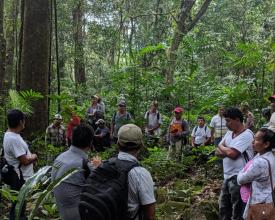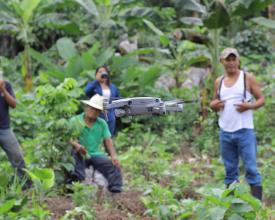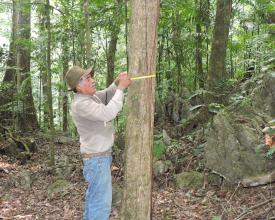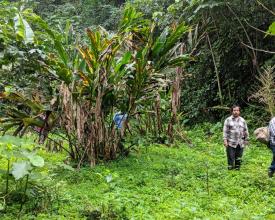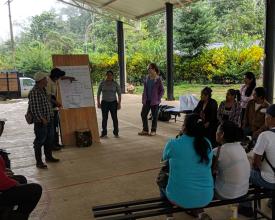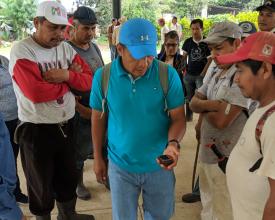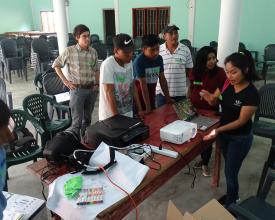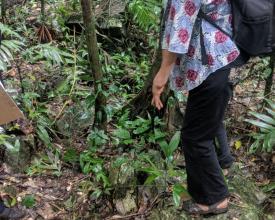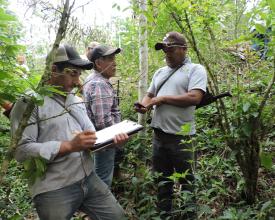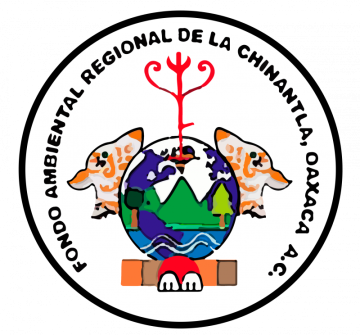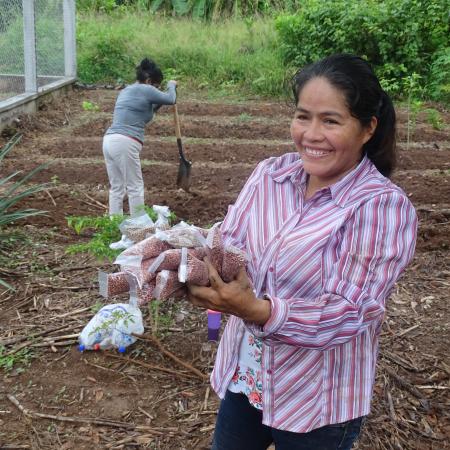
Autonomisation et résilience des communautés dans la région de Chinantla : Renforcer les capacités de surveillance des forêts au niveau local
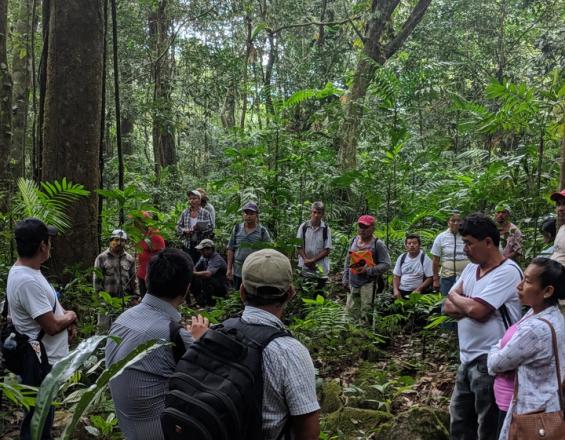
Cette solution permet de lutter contre la déforestation et la perte d'habitat dans les forêts tropicales de la région montagneuse de Chinantla, dans le nord de l'État d'Oaxaca, au Mexique, tout en améliorant les moyens de subsistance des habitants de la région, qui sont principalement des indigènes. Les forêts écologiquement importantes de Chinantla comprennent les dernières forêts de nuages et la troisième plus grande forêt tropicale du Mexique, et font partie du point chaud de la biodiversité mondiale de Méso-Amérique. La région de Chinantla est également reconnue par le gouvernement mexicain comme une région prioritaire pour la conservation. Le paysage et ses habitants indigènes, qui ont une longue histoire de pauvreté et de marginalisation socio-économique, sont de plus en plus vulnérables aux effets du changement climatique. Grâce à une collaboration entre le Fonds de développement EcoLogic et son partenaire local, le Fondo Ambiental Regional de la Chinantla (FARCO), cette solution se concentre sur la restauration des forêts, la réduction de la pression sur les ressources forestières, la protection des terres par les communautés, le renforcement des capacités et la création de revenus forestiers durables.
Contexte
Défis à relever
Environnement :
-
Perte de terres forestières en raison des incendies de forêt, de l'exploitation illégale des forêts et de la saisie par le gouvernement
-
Dégradation des forêts
-
L'écosystème local est de plus en plus vulnérable aux effets du changement climatique, notamment aux sécheresses et aux chaleurs extrêmes.
-
Biodiversité et habitats menacés
-
Les communautés n'ont pas les compétences et les capacités nécessaires pour collecter les données requises pour bénéficier des programmes nationaux d'incitation à la gestion de l'environnement.
la situation socio-économique :
-
Pressions exercées par des groupes extérieurs pour exploiter les terres à des fins d'élevage et de cultures commerciales.
-
Les résidents indigènes ont une longue histoire de pauvreté et de marginalisation socio-économique.
-
Les membres de la communauté ont des choix limités pour gagner un revenu et sont souvent poussés vers des activités génératrices de revenus qui sont nuisibles à l'environnement.
-
Insécurité alimentaire
-
Absence de souveraineté foncière pour les résidents indigènes vivant dans ou près des forêts
Emplacement
Traiter
Résumé du processus
Nous ne travaillons qu'avec les communautés qui ont demandé notre aide. Nous commençons donc par identifier les communautés qui ont exprimé un besoin en termes de menaces pour leurs écosystèmes locaux ou leurs moyens de subsistance (BB1). Nous travaillons ensuite avec la communauté pour élaborer un plan adapté au contexte afin de répondre à ces besoins en matière d'environnement et de moyens de subsistance (BB2). Nous aidons les communautés à accéder à la formation, aux outils, aux compétences et au soutien financier et technique. Nous pensons que les résidents locaux qui vivent à l'intérieur ou à proximité des forêts menacées sont les mieux placés pour les protéger. C'est pourquoi, grâce au renforcement des capacités, nous donnons aux membres de la communauté les moyens de s'approprier le projet et de s'engager dans la surveillance et la protection de la forêt par la communauté (BB3). Les "gardiens" des forêts que nous formons peuvent partager leurs connaissances avec les membres de leur famille, leurs voisins et les membres de leur communauté et les inciter à protéger les forêts. L'agroforesterie et la restauration des forêts (BB4) constituent un autre aspect essentiel de ce plan. La reforestation aide à restaurer les terres dégradées, contribuant ainsi à un climat plus stable et à une meilleure résistance au changement climatique. L'agroforesterie permet d'améliorer la sécurité alimentaire et de multiplier les opportunités économiques, tout en améliorant la santé des sols et en réduisant la pression sur les ressources forestières et les sources d'eau.
Blocs de construction
Processus participatif d'identification des communautés bénéficiaires
Ce projet repose sur une philosophie qui consiste à travailler avec les communautés qui ont demandé un soutien, de sorte que la solution soit guidée par les priorités de la communauté plutôt que d'imposer des objectifs ou des valeurs extérieurs. La première étape, qui consiste à identifier les communautés bénéficiaires par le biais de processus participatifs, est essentielle à la réussite du projet, car la confiance et la collaboration permettront d'obtenir de meilleurs résultats. L'investissement communautaire et la volonté de s'engager dans des actions durables sont également des traits essentiels à identifier chez les communautés bénéficiaires, car ce sont elles qui prendront la tête des efforts de conservation et de restauration de leur écosystème.
Facteurs favorables
-
Les organisations partenaires locales et/ou le personnel de terrain assurent la liaison avec les communautés rurales et indigènes, établissant ainsi des relations et un climat de confiance.
-
Le personnel local sur le terrain organise des assemblées communautaires
Leçon apprise
- Il est important d'instaurer un climat de confiance avec les communautés, qui peuvent avoir eu des expériences négatives avec des agents ou des groupes extérieurs exerçant des pressions sur leurs terres.
Renforcer les capacités de la communauté en fonction des besoins locaux
Cette solution a été reproduite avec succès dans plusieurs communautés différentes en écoutant d'abord attentivement les besoins de la communauté bénéficiaire actuelle, puis en élaborant avec elle un plan qui répond aux objectifs et aux résultats souhaités. Grâce à la formation, aux ateliers et à l'assistance technique du personnel local sur le terrain, des compétences et des capacités spécifiques sont développées au sein de la communauté pour permettre aux habitants de prendre en charge la restauration de leurs écosystèmes. Après le soutien financier et technique initial, bon nombre de ces actions deviendront durables au fil du temps et nécessiteront moins de soutien de la part des partenaires.
Facteurs favorables
-
Ateliers initiaux organisés pour écouter et documenter les priorités et les objectifs des communautés
-
Le personnel local sur le terrain est disponible pour fournir un soutien technique et une formation.
Leçon apprise
- Les solutions et les activités adaptées à la culture et au contexte de la communauté ont plus de chances d'être maintenues à long terme.
Surveillance et protection des forêts par les communautés
La responsabilisation de la communauté pour qu'elle prenne en charge la surveillance de la forêt et les objectifs de conservation est un élément clé de cette solution reproductible. Une fois que les dirigeants bénévoles de la communauté ont été identifiés, ils reçoivent la formation, les outils et le matériel nécessaires à leur plan de gestion. Ils peuvent également collaborer avec les forces de l'ordre locales pour surveiller l'exploitation forestière illégale et d'autres formes d'extraction de la biodiversité de la forêt. Certaines communautés de la région de Chinantla avaient besoin de données scientifiques sur le suivi des forêts pour pouvoir postuler à un programme national de rémunération en échange d'un travail de gestion de l'environnement. Les éléments de formation et de renforcement des compétences du projet ont été adaptés pour répondre à ce besoin, de sorte que les membres de la communauté ont été formés à la collecte de données forestières afin d'être en mesure de collecter ces informations par eux-mêmes, devenant ainsi éligibles au programme de paiement des services écosystémiques.
Facteurs favorables
-
Les communautés bénéficiaires qui se sont déclarées désireuses d'être aidées sont plus enclines à prendre la direction des activités de surveillance des forêts.
-
Les membres de la communauté qui le souhaitent sont en mesure d'assumer des rôles de leadership bénévole.
-
Les activités de suivi sont basées sur un plan de gestion élaboré avec la communauté.
Leçon apprise
- Les leaders communautaires deviennent des champions de l'écosystème local et peuvent inspirer d'autres membres de leur famille et de leur communauté.
Agroforesterie et restauration des forêts
L'agroforesterie et la restauration des forêts sont des éléments clés de notre solution reproductible, car elles nous aident à atteindre les objectifs de restauration des paysages tout en offrant des avantages locaux tels qu'une meilleure qualité des sols et la production de cultures.
Facteurs favorables
- Le personnel local sur le terrain est disponible pour fournir une assistance technique et une formation sur la mise en œuvre.
Leçon apprise
-
Les communautés qui se sont engagées dans l'agroforesterie et le reboisement peuvent organiser des échanges d'apprentissage avec les communautés voisines qui commencent à s'engager dans l'agroforesterie afin de transmettre les connaissances, d'agriculteur à agriculteur.
Impacts
Impacts sur l'environnement :
-
Maintien et augmentation du couvert forestier sur 8 000 ha dans deux municipalités de la région de Chinantla.
-
Le reboisement des terres dégradées contribue à l'absorption des émissions de gaz à effet de serre, à un climat plus stable et à une plus grande résistance aux effets du changement climatique.
-
La biodiversité et les habitats sont protégés grâce à la surveillance et à la restauration des forêts.
-
Les membres de la communauté sont dotés des capacités techniques nécessaires pour collecter des données scientifiques sur la surveillance des forêts grâce à des ateliers et à des formations, ce qui leur permet de bénéficier de programmes d'incitation à la gestion de l'environnement.
Impacts socio-économiques :
-
Les activités de subsistance durables (parcelles agroforestières, petites entreprises, etc.) offrent de nouvelles possibilités de revenus aux communautés et les détournent des ressources forestières.
-
Amélioration de la sécurité alimentaire grâce à l'adoption de pratiques telles que l'agroforesterie et la création de jardins familiaux et communautaires.
-
Rétablissement de la souveraineté foncière des membres de la communauté
-
Amélioration du bien-être général des résidents grâce à une plus grande sécurité économique et alimentaire
Bénéficiaires
- Les hommes, les femmes et les enfants des communautés rurales et principalement indigènes de la région de Chinantla (environ 85 976 personnes).
-
Les générations futures qui habiteront les communautés et s'engageront dans l'écosystème
Objectifs de développement durable
Histoire

"Je prends soin de la terre parce qu'elle prend soin de moi et me donne la vie, l'eau et la nourriture. Même si je le fais en tant que bénévole, je porte fièrement ma chemise pour montrer que je fais partie de la brigade de surveillance de ma communauté"- Andrés Sánchez, 60 ans, Vega del Sol
"Les jardins familiaux et les initiatives d'agroécologie sont d'une grande aide pour l'économie locale, c'est tellement bien quand on récolte déjà... mais il faut d'abord semer et cela demande beaucoup de travail, mais nous le ferons encore. - Carmen Gutierrez, San José Chiltepec
"Je considère la certification comme un exemple à suivre pour dire : vous conservez sans détruire la zone à laquelle le certificat est attribué... Il faut noter le nombre d'hectares et l'emplacement de la zone que nous conservons. Nous prenons un engagement et nous le respectons... pour prendre soin de cette zone pendant 10 ans ou plus". -Abel Delfin, Santa María Jacatepec
